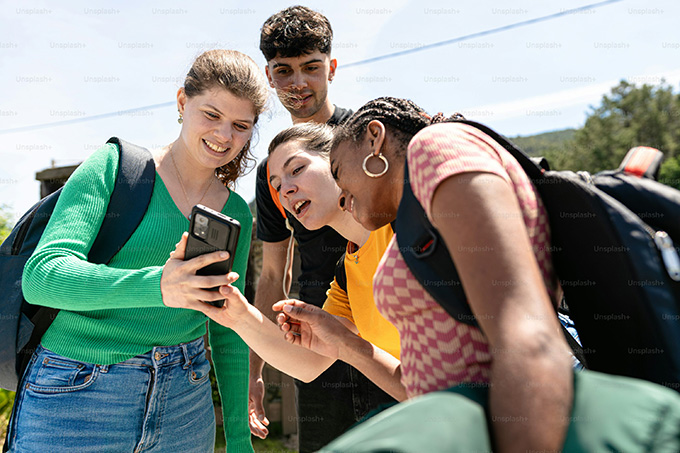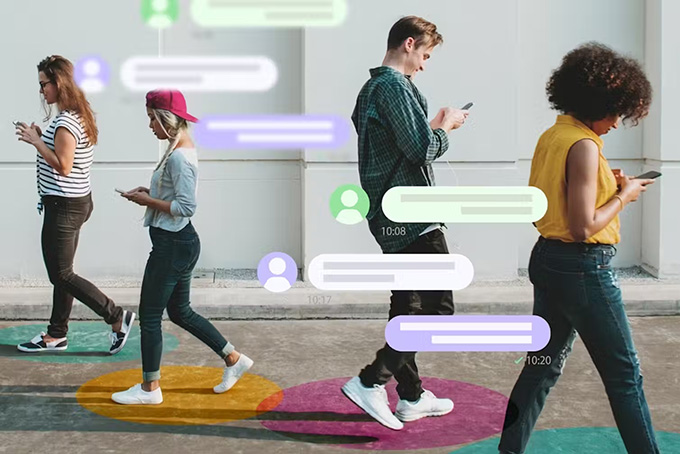 In recent decades, the diffusion of information technologies to a wide variety of audiences and the associated possibilities for data collection have contributed to the development of new forms of surveillance.
Mass surveillance, conceived in its highly vertical form, is now superimposed on interpersonal, participatory surveillance, in which everyone becomes both observed and observer. Adolescents are particularly affected by the exacerbation of this social surveillance.
To examine the motivations and purposes of these surveillance practices among adolescents, we rely on two qualitative surveys. One concerns the use of platforms such as Snapchat and Instagram . The other asks more specifically about geolocation surveillance .
In recent decades, the diffusion of information technologies to a wide variety of audiences and the associated possibilities for data collection have contributed to the development of new forms of surveillance.
Mass surveillance, conceived in its highly vertical form, is now superimposed on interpersonal, participatory surveillance, in which everyone becomes both observed and observer. Adolescents are particularly affected by the exacerbation of this social surveillance.
To examine the motivations and purposes of these surveillance practices among adolescents, we rely on two qualitative surveys. One concerns the use of platforms such as Snapchat and Instagram . The other asks more specifically about geolocation surveillance .
Which tools for which monitoring?
Checks on the presence or availability of adolescent peers are becoming increasingly numerous, intrusive and most often cumulative.
In this context, the communication platforms used by these young audiences are not neutral. They promote features that directly serve to track, both online and offline, the activity of others. Those defined as instant messaging specify the time of each contact’s last connection or whether a message has been read. This information is added to the time the message was read and, if applicable, whether the recipient is currently responding to it.
Others, like Snapchat, also offer various metrics such as Snapscore (a reflection of an individual’s real-time activity) or friendship metrics with flame counts (maintaining which necessarily involves sharing content daily). Emojis also reflect the frequency and regularity of conversations with a particular person.
Even more intrusive, the SnapMap displays the geographic position of peers on a digital map, which possibly reveals the offline side of their activities and movements.
Monitor to reassure yourself, monitor to justify yourself?
While the range of possibilities is expanding in terms of surveillance, it remains to be understood why and how adolescents collect and exploit this information. Curiosity is frequently invoked in interviews, but never emerges as a fully satisfactory argument: the young people interviewed demonstrate, in practice, more complex motivations.
Some teenagers say they monitor for authentication purposes , for example by checking that a friend’s location matches what they said it did or, at the very least, doesn’t bode well for anything unexpected. In the same vein, others use geolocation to confirm that a friend has indeed gone on a trip or is at their home in the evening.
By an almost inevitable shift, it is then a matter of adolescents monitoring in order to prove , anticipating that content that is sometimes of little interest at the time may be used later and, for example, deconstruct a lie. The information collected then becomes considered as irrefutable demonstrations of a situation experienced (screenshot of an ephemeral photo, of an unexpected geographical position, etc.) and acquires a probative purpose.

Communication platforms promote features that directly serve the tracking, both online and offline, of the activity of others. Shutterstock
Tensions and ambiguities
While it is therefore expected that the sharing of certain content and personal data online must be controlled with great rigor, and the adolescents interviewed unsurprisingly present the fact of “getting caught” as difficult to recover from, it remains socially complex to hide.
Among other strategies, some young people adapt their digital practices to their audience, favoring the use of certain social media networks on which they “show less” with specific contacts. They can also use “ghost mode” on Snapchat, but the irregularity of its activation and deactivation fuels suspicion and the need to justify themselves.
Among the adolescents surveyed, not connecting to communication platforms is most often acceptable. It is “sometimes regretted but understandable,” while voluntary disconnection at intervals is more often seen as a desire to escape the mutual surveillance that has become widely commonplace in the daily lives of connected individuals. So much so that surveillance does not appear exclusively as a constraint: its beneficial nature is also highlighted several times in our two surveys.
Depending on the content, especially when it involves close friendships or romantic relationships, viewing and taking a screenshot of a story is expected. Worrying about a non-reply after making sure a message was read is sometimes welcome. Occasionally checking a loved one’s location can be seen as a sign of thoughtfulness, if not a reassuring exercise of vigilance.
It’s all about moderation, “good frequency” and a reasoned use of surveillance that outlines its acceptability, even if “the guy who screens too much, we avoid him in the corridors,” admits Florence, 15.
Contemporary adolescents therefore find themselves caught up in highly intense surveillance logics through social networks and communication platforms. Especially since this surveillance often goes beyond their interpersonal relationships and now extends into the intra-family circle ( parental monitoring tools and geolocation of children ) or into the school field (with Pronote as a powerful information collection device).
Author Bio: Yann Bruna is a Lecturer in Sociology at Paris Nanterre University – Paris Lumières University
 In recent decades, the diffusion of information technologies to a wide variety of audiences and the associated possibilities for data collection have contributed to the development of new forms of surveillance.
Mass surveillance, conceived in its highly vertical form, is now superimposed on interpersonal, participatory surveillance, in which everyone becomes both observed and observer. Adolescents are particularly affected by the exacerbation of this social surveillance.
To examine the motivations and purposes of these surveillance practices among adolescents, we rely on two qualitative surveys. One concerns the use of platforms such as Snapchat and Instagram . The other asks more specifically about geolocation surveillance .
In recent decades, the diffusion of information technologies to a wide variety of audiences and the associated possibilities for data collection have contributed to the development of new forms of surveillance.
Mass surveillance, conceived in its highly vertical form, is now superimposed on interpersonal, participatory surveillance, in which everyone becomes both observed and observer. Adolescents are particularly affected by the exacerbation of this social surveillance.
To examine the motivations and purposes of these surveillance practices among adolescents, we rely on two qualitative surveys. One concerns the use of platforms such as Snapchat and Instagram . The other asks more specifically about geolocation surveillance .